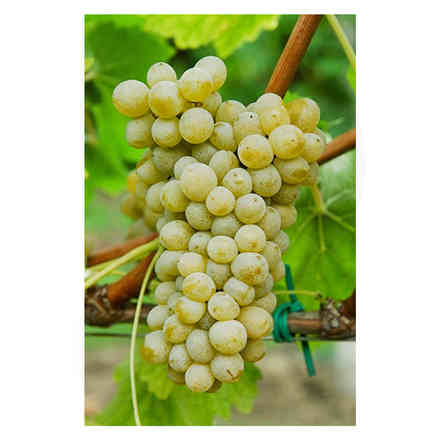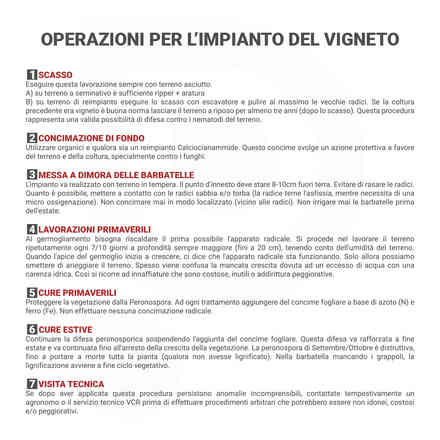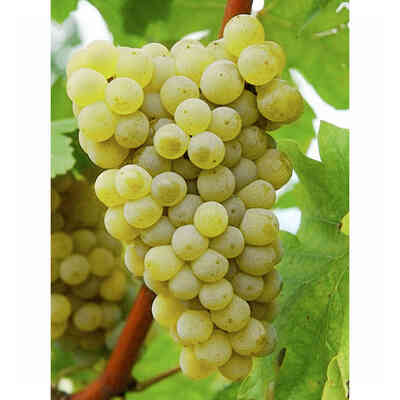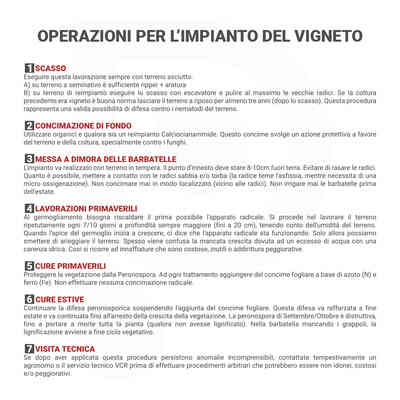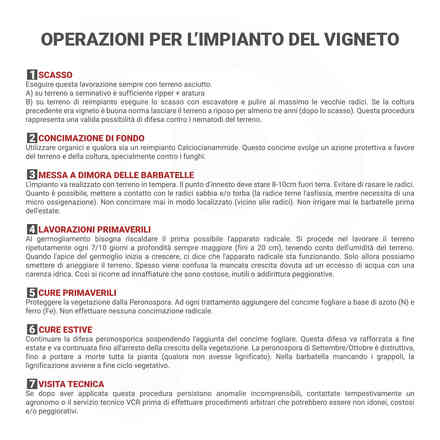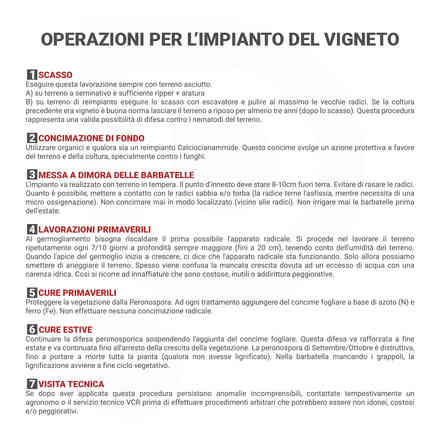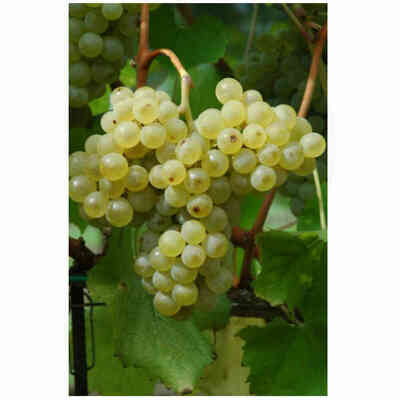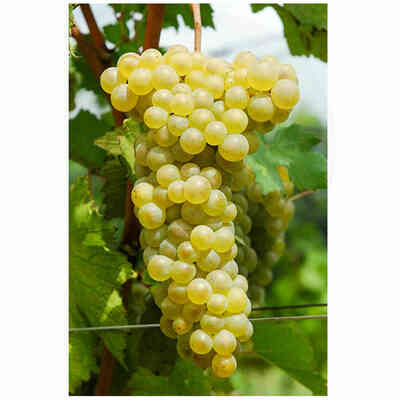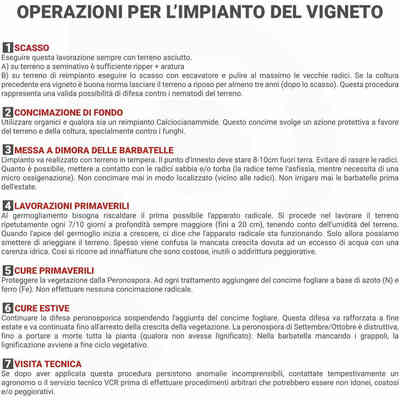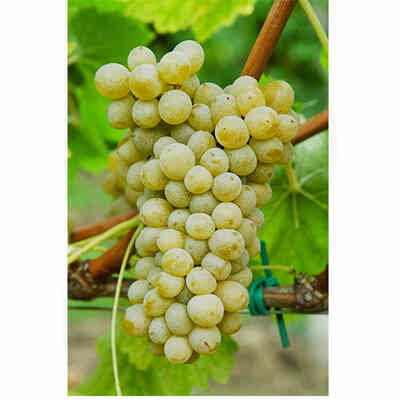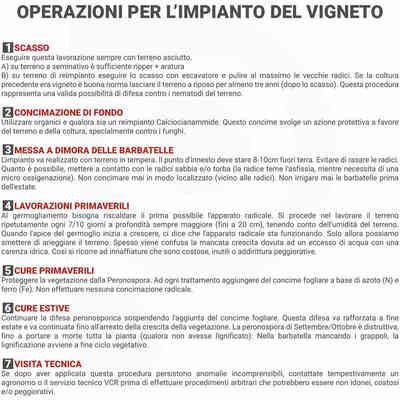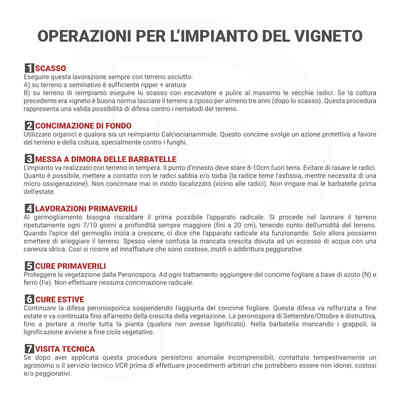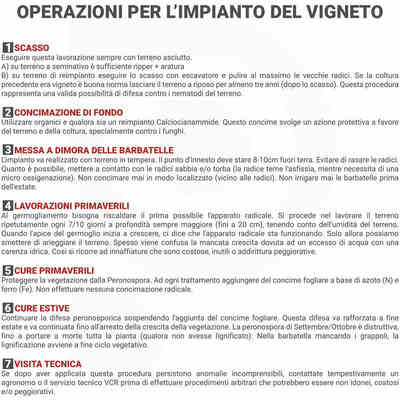Trebbiano Toscano (10 pieces)
Description
 AUTHORIZED RETAILER
AUTHORIZED RETAILER
Trebbiano Toscano (10 pieces)
Rootstocks: 1103P - K5BB - S04 - 140RU - 420A (We will send the graft carrier available at the moment)
A very vigorous vine, probably originating from the eastern Mediterranean basin, it spread first in Italy and then in France (Ugni Blanc). In our country it is grown mainly in the Centre and South, including the Islands; in the North it is cultivated only in some warm and sunny wine-growing areas.
- Ampelographics: the population variety is fairly homogeneous apart from the presence of pronounced sweet millerandage in some biotypes and the shape of the bunch, which may or may not bifurcate at the tip. Sprout with a semi-expanded, downy apex, white in colour with golden highlights. Leaves: large, pentagonal, trilobate, blistered, underside downy. Petiolar sinus in the shape of a closed lyre with overlapping edges. Bunch large, cylindrical or conical with evident wings, rightly spreading or semi-compact. Berry: medium, spheroid, light yellow, transparent; skin of medium consistency; loose, juicy, acidulous-sweet, neutral flesh.
- Cultivation requirements: vigorous vine with semi-erect vegetation habit and strong shoots with medium internodes that are easy to break at the base in the first vegetative phase. Adapts to different environments preferring hot-dry climates where it can give a good quality product; suffers from prolonged summer drought.
- Cultivation and pruning: adapts to different forms of cultivation, although it prefers medium-long and rich pruning; accepts spurs of 3-4 buds in central-southern Italy. In the counter-espalier system, the shoots must be properly tied or inserted in a double-track wire to avoid breaking.
- Sprouting time: late.
- Ripening period: late.
- Production: abundant and constant; prolonged summer drought in hot climates reduces production and quality of the grapes, so adequate irrigation or cool soil is essential.
- Sensitivity to disease and adversity: normal, a little sensitive to powdery mildew. Escapes late frost but suffers from wind and winter cold.
- Oenological potential: yields a straw-yellow wine, with a light floral bouquet, slim in body, lively in acidity, fairly sapid, good drinkability even if not very characteristic.
- We recommend vinification or blending with other wines such as Malvasia Toscana, Verdicchio, Vernaccia di S. Gimignano, Chardonnay, Sauvignon, Bombino Bianco, etc. Widely used for the production of Cognac and Brandy.
Clones in multiplication: Trebbiano Toscano R 4, VCR 8, SANTA LUCIA 30, T 34 ICAPG, CSVAPTR 1, CSVAPTR 2, CAB 19, CSVAPPS 2, CSVAPPS 3, CSVAPPS 7, CSVAPPS 8; Ugni Blanc (French clones Inra-Entav) 384, 478.
Clones soon to be submitted for approval: Trebbiano Toscano VCR 352, VCR 353, VCR 454, VCR 479.
CULTIVATED AREA IN ITALY
YEAR 1970 1982 1990 2000 2010
HECTARES 46,182 56,301 58,476 42,457 42,446
CULTIVATED AREA IN ITALY
YEAR 1968 1979 1988 1998 2006
HECTARES 93,762 127,468 102,973 95,740 83,182
RULES TO PLANT A VINEYARD
1. PLOW
You must perform this operation always with dry soil
A) On arable land is generally sufficient to ripper + to plow
B) On planting soil is generally sufficient to plow with an escavator and to clean the old roots.
If the previous crop was a vineyard, it is a good idea to leave the soil fallow for at least three years (after plowing). This procedure represents a valid possibility of defence against soil nematodes.
2. SOIL FERTILIZATION
Use organics and if it is a reimplantation, use Calciumocyanamide.
This fertiliser has a protective effect on the soil and the crop, especially against fungi.
3.PROPAGATING GRAPE VINE CUTTINGS
The planting should be carried out in temperate soil. The grafting point should be 8-10 cm above ground. Avoid shaving the redices. As much as possible, put sand and/or peat in contact with the roots (the root fears asphyxiation, while it needs a micro-oxygenation). Never fertilize in a localized manner (near the roots). Never water the rooted cuttings before summer.
4.SPRING WORKS
When sprouting, the root apparatus must be heated as soon as possible. Work the soil repeatedly every 7/10 days at increasing depth (up to 20 cm), taking into account the moisture of the soil. When the apex of the bud starts to grow, it means that the root system is functioning. Only then can we stop watering the soil. Failure to grow due to access to water is often confused with a lack of water. This is why watering is used which is expensive, useless or even worse.
5.SPRING CURE
Protect vegetation from Peronospora. To each treatment add nitrogen (N) and iron (Fe) foliar fertilizer. Do not make any radical fertilization.
6.SUMMER CURE
Continue with the defense against Peronospora by suspending the addition of the foliar fertilizer. This defense should be reinforced in late summer and should be continued until vegetation growth stops.
The September/October blight is destructive, to the point of bringing death to the whole plant (if it has not lignified). The rooted vine lacks clusters, so lignification occurs at the end of the vegetative cycle.
7.TECHNICAL VISIT
If incomprehensible anomalies persist after this procedure, contact an agronomist or the VCR Technical Service promptly before carrying out arbitrary procedures which may be unsuitable, expensive and/or worsening.





















